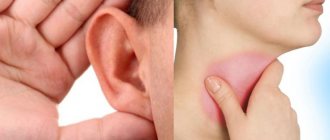Pain in the throat and ear is a clinical manifestation of a number of otolaryngological diseases, and much less often - neoplasms of a malignant nature. Most often it is one-sided and signals the presence of inflammatory processes occurring in the sinuses, tonsils, lymph nodes and larynx. Treatment of chronic sore throat is aimed at eliminating inflammatory processes and pain symptoms. For this, the otolaryngologist prescribes medications.
The otolaryngology department of CELT offers diagnosis and treatment of chronic ear pain. Our multidisciplinary clinic has been operating in the paid medical services market in Moscow for almost thirty years. Our specialists operate with international treatment standards and have everything necessary for accurate diagnosis and effective treatment in accordance with them.
At CELT you can consult an otorhinolaryngologist.
- Initial consultation – 3,000
- Repeated consultation – 2,000
Make an appointment
Causes of chronic pain in the throat and ear
Pain in the throat and ear, without or with fever, is one of the most common complaints of patients visiting an otolaryngologist. On average, about 15% of patients seek professional help. As already mentioned, most often the pain occurs on one side; There are also cases when it covers both sides.
The reasons for this phenomenon lie in pathological processes affecting several anatomical structures, but not necessarily. There are often cases when the pain radiates to the ear when the throat is affected. The features of human anatomy are such that the ear, throat, mouth and nose form a communicating system, interconnected by channels.
When inflammation develops in any of the organs, the process spreads through these channels, affecting other structures of the system - the organs of hearing and the pharynx - which provokes pain in the throat and ear. The patient may complain of a sore throat radiating to the ear - or, conversely, the appearance of pain in the organ of hearing and spreading to the throat. It also happens that the patient cannot accurately determine the source of pain.
Symptoms in the form of pain are characteristic of a wide range of pathological conditions, which you can learn about by reading our tables presented in the following sections.
Exercises to relieve pain
- Rotations and bends will help relieve acute pain anywhere: on the subway, during your lunch break at work, on the road, if you are not driving. Start with a rotation - smoothly lower your head to the left, move it to the right, carefully lowering your chin to your chest, then pause in the other direction. Slowly turn your head to the right, hold for 5 seconds, return to the forward-facing position, repeat on the other side.
- Dog pose is especially beneficial for those who have neck pain that radiates to the shoulder. Get on all fours with your hands and knees shoulder-width apart. Bend at the waist, lift your buttocks, leaning on your hands and straightening your knees. Try to keep your arms and back in one line.
- Slip. Sitting with a straight back, push your chin forward, then pull it back. It should slide in a straight line.
What else can you do for neck pain?
Massage. There are trigger points or muscle knots in the neck muscles that irritate the muscles, causing pain. With gentle rubbing and pressing you can reduce it. You can find such points by running your fingers along the surface of the neck; trigger points are dense stripes under the skin.
Collar. You can use a ready-made one or make something like a collar yourself. Roll up the towel and wrap it around your neck so that the base of your skull rests on the top of your collar.
Compress. In the first two days after the pain appears, it is better to apply a cool compress. Afterwards, warming up is allowed with a heating pad, or if you don’t have one, with a towel soaked in hot water.
Diseases of the throat and ear, in which pain in the throat radiates to the ear
| Pathology causing symptoms | What is it characterized by? |
| Lymphadenitis | Inflammatory damage to the lymph nodes due to damage by bacteria or viruses. It can occur in acute or chronic form and manifests itself:
|
| Rhinitis | Inflammatory processes of the nasal mucosa, which can develop due to viral lesions. They appear:
|
| Sinusitis | Inflammation that covers the paranasal sinuses, developing when they are damaged by bacteria, viruses or fungi. Depending on the localization of pathological processes, sinusitis is divided into sinusitis, frontal sinusitis, and ethmoiditis. Their clinic provides for increased body temperature, headaches, sore throat, radiating to the organ of hearing. |
| Tonsillitis | Inflammatory lesion of the tonsils, developing as a result of damage by pathogenic microorganisms. The pain during the disease is acute and radiates to the ear, and in the chronic form it is sticky. The patient's throat has a burning sensation and soreness, and a reflex cough develops. |
| Otitis | Inflammation that affects the external, middle or internal parts of the hearing organs, and occurs in acute or chronic form. Pain with it is accompanied by a significant deterioration in well-being. Often otitis media occurs along with tonsillitis, causing a sore throat. |
| Pharyngitis | Inflammatory damage to the mucous membrane of the pharynx due to damage by bacterial or viral agents. Very often it occurs together with tonsillitis and, in addition to pain in the ear and throat, is manifested by the following symptoms:
|
Diagnostics
Patients who have neck pain on the side require an initial consultation with a general practitioner or traumatologist, then, according to indications, the person is referred to related specialists. A diagnostic search involves conducting modern instrumental imaging methods to determine the cause of pain and prescribing additional laboratory tests. The most informative are:
- Sonography
. Ultrasound of the cervical region is used to study the condition of internal organs, lymph nodes and endocrine glands. The study allows you to detect space-occupying formations, ulcers, and cysts. Additionally, an ultrasound of the abdominal organs is performed. - X-ray examination
. To exclude a vertebrogenic cause of neck pain on the right, an X-ray of the cervical spine is performed in frontal and lateral projections. If dislocations or traumatic injuries to the atlas are suspected, an image is taken through the mouth. - Examination of ENT organs
. Often, pain syndrome is caused by severe diseases of the respiratory tract, so pharyngoscopy and indirect laryngoscopy are necessary. If suspicious signs are detected, endoscopy of the larynx and pharynx is performed. - Neurological examination
. Pain in the neck area can be a consequence of pathological processes in the central nervous system, so superficial and deep tendon reflexes and coordination of movements must be studied. If necessary, a CT or MRI of the brain is done. - Blood chemistry
. The levels of acute phase indicators and the percentage of protein fractions are determined, which is necessary to exclude signs of the inflammatory process. Liver tests, pancreatic enzymes, and a complete blood count are assessed.
When ultrasound reveals large formations of the thyroid gland, a fine-needle biopsy of the node is required, followed by cytomorphological examination. Be sure to do a blood test for thyroid-stimulating hormones of the pituitary gland, T3 and T4, and parathyroid hormone. In some cases, duplex scanning of the neck vessels is required to assess the speed of blood flow. If it is suspected that the superior vena cava is compressed, radiography of the OGK is indicated to exclude mediastinal tumors.
Common diseases that cause pain in the throat and ear
| Pathology | What is it characterized by? |
| Diphtheria | An acute infectious disease that develops as a result of exposure to bacterial agents. It is manifested by the development of fibrinous inflammatory processes in the area where the latter is introduced. Most often these are the upper respiratory tract, bronchi or oropharyngeal mucosa. |
| Measles | An acute infectious viral disease, manifested by the appearance of a rash on the skin, fever and pain in the throat, radiating to the ear. Its complication is often otitis media, which also causes pain. |
| Scarlet fever | Acute infectious processes that begin with a sore throat and are characterized by primary damage to the oropharynx, as well as pronounced intoxication. |
Other causes of sore throat and ear pain
In addition to sore throat and ear pain, all of the above inflammatory pathologies have one more common symptom: increased body temperature. However, there are other reasons for which pain symptoms occur, and they are not associated with inflammation. Therefore, there is no elevated temperature with them or occurs only when the process is neglected.
| Initiating factor | What is it characterized and manifested by? |
| Traumatic injuries to the mucous membrane | Pain can occur due to a burn (thermal or chemical), ingress of a foreign body, or mechanical impacts. |
| Neoplasms of benign and malignant etiology | Benign and malignant neoplasms of the larynx are a fairly rare phenomenon that can make it difficult to eat and cause pain. Requires seeking professional medical help. |
How to prevent it?
To prevent neck pain, sit with your neck and back straight. Organize your workspace so that when sitting, your hips are higher than your knees. Do not tilt or move your head forward. Here is a clear example of how you should and should not work at a computer:
Place your feet flat on the floor and adjust the height of the chair to suit your height. Change your position, you can lean back from time to time.
When lying down, place a pillow under your head and neck so that it touches your shoulders. This will relieve the neck muscles. Keep your head level as you go to sleep.
Treatment of sore throat and ear
To relieve a patient of a sore throat, it is necessary to accurately determine the cause that provokes it. CELT specialists conduct comprehensive diagnostic studies that eliminate the risk of error. For this, the patient is prescribed to undergo general laboratory tests, bacterial culture, X-ray and pharyngoscopy. Treatment tactics are developed based on the results obtained and the patient’s individual indications.
| Pathology | Treatment |
| Lymphadenitis | The acute form is treated conservatively: taking antibiotics and vitamins, as well as UHF. The purulent process is opened and drained. The chronic form requires elimination of the underlying disease, which provokes inflammatory processes in the lymph nodes and pain. |
| Rhinitis | The acute form is treated with medications, heat treatments and antibiotics if a bacterial agent is identified. As for chronic, it requires the use of astringents, antibacterial ointments, instillation of antiseptics and UHF. According to indications, cauterization of the nasal mucosa or cryodestruction is performed. |
| Sinusitis | Treatment is aimed at eliminating the inflammatory process and ensuring the outflow of purulent masses from the paranasal sinuses. The latter allows you to eliminate pain. The patient is prescribed antibacterial or antiviral drugs, and a maxillary sinusotomy is performed according to indications. |
| Tonsillitis | Treatment tactics are selected depending on the form and stage of the disease and provide an integrated approach. In the process, local procedures and drug treatment with the use of immunostimulants and immunocorrectors are used, which reduces pain and improves the general condition of the patient. Surgical treatment is aimed at removing the tonsils and is carried out according to indications if lymphoid tissue has been replaced by connective tissue. |
| Otitis | Treatment depends on which part of the hearing organ is affected. It is possible to use antiseptics that are injected into the ear canal. In addition, warm compresses, physiotherapeutic procedures, and the use of topical anti-inflammatory drugs are recommended. If the above does not give the desired result, the eardrum is pierced to ensure the drainage of pus. This automatically reduces pain and the patient feels relief. |
| Pharyngitis | It is important to eliminate the factors that provoke the disease. The patient should avoid consuming foods that can cause irritation to the mucous membrane. If a bacterial agent is detected, antibiotic therapy is administered. Local treatment involves rinsing with antiseptics and inhalation. |
Having decided to undergo a course of treatment for chronic pain in the throat and ear at CELT, you will have an appointment with doctors of the highest category and candidates of medical sciences. They will help you get rid of unpleasant symptoms by eliminating the cause of their development. You can make an appointment with them online or by contacting our operators.
Make an appointment through the application or by calling +7 +7 We work every day:
- Monday—Friday: 8.00—20.00
- Saturday: 8.00–18.00
- Sunday is a day off
The nearest metro and MCC stations to the clinic:
- Highway of Enthusiasts or Perovo
- Partisan
- Enthusiast Highway
Driving directions
Causes of side neck pain
Staying in an awkward position
Short-term pain on the side of the neck is possible in completely healthy people.
It is typical for pain to appear in the morning, immediately after waking up - due to sleeping on a pillow that is too high or uncomfortable, the right or left side of the neck hurts. The person also complains of stiffness of the spine in the cervical region, difficulty turning and tilting the head. In typical cases, discomfort disappears within 15-20 minutes; long-term persistence of pain indicates pathological processes in the muscular-ligamentous apparatus. The symptom often develops in gamers, programmers, and other people who spend a lot of time working at the computer and do not maintain proper posture. Pain in the lateral muscles of the neck appears more often in the evening, after a working day. Similar disorders are observed in people with scoliosis who walk with their torso and head tilted, which causes strain on the neck muscles on the side of one side. Frequent episodes of cervicalgia or high intensity pain are indications for contacting a specialist to rule out a more serious cause of discomfort.
Myositis
Inflammatory diseases of the cervical muscles are provoked by hypothermia, exposure to drafts, and sudden head movements. The neck begins to hurt on the side when the sternocleidomastoid or other muscles of this group are affected. The pain with cervical myositis is sharp, shooting, intensified by moving the head, after muscle strain. The skin over the inflamed muscles acquires a reddish tint, swelling and slight asymmetry of the neck are noted. Symptoms persist for 4-5 days, then the pain in the neck subsides.
Acquired torticollis
Pathological deformation of the cervical region, which is combined with moderate pain on the side on the affected side, occurs in adults due to spinal injuries, extensive scars after skin burns. With torticollis, a characteristic position of the head is observed: it is tilted to one side towards the sore muscle, while the chin and face are turned in the opposite direction. Whenever you try to change the tilt of your head, you feel sharp pain on one side, caused by muscle strain. When returning to the forced position, the pain on the side of the neck decreases, but does not disappear.
Retropharyngeal abscess
When an abscess forms in the retropharyngeal tissue, sharp shooting or throbbing pains on the side of the neck and in the throat with irradiation into the mastoid process of the occipital bone and teeth are disturbing. The pain syndrome can be so severe that patients with a retropharyngeal abscess refuse to eat and drink and prefer not to talk, so as not to aggravate the suffering. Pain in the neck on the right can be combined with breathing problems due to partial occlusion of the lumen of the larynx and trachea. To reduce pain, a person takes a forced position with his head thrown back and tilted towards the affected side.
Lymphadenitis
Painful sensations of varying intensity along the lateral surfaces of the neck can be associated with inflammatory processes in the lymph nodes located in the submandibular and postauricular area. Lymphadenitis is caused by causes such as acute respiratory viral infections, bacterial and fungal infections of the oral cavity, and respiratory tract. The pain can be unilateral or bilateral, depending on the number of lymph nodes involved in the process. Patients describe the pain as sharp, pulsating, shooting. The skin over the inflamed formations is red, tense, and swollen.
Osteochondrosis of the cervical spine
With degenerative changes in the vertebrae and intervertebral discs, nerve endings and roots are often pinched, which leads to “lumbago” when the neck hurts on the left or right side. The symptom occurs suddenly. The pain is very strong, sometimes a person literally “freezes” in one position and is afraid to move, so as not to aggravate the pain in the cervical region. Cervicalgia is often accompanied by irradiation to the shoulder girdle, shoulder or scapula. The duration of the attack ranges from several minutes to an hour; after the pain subsides, discomfort and tension in the neck muscles remain.
Chronic damage to intervertebral discs, protrusion and hernia are common causes of cervical or occipital neuralgia, manifested by pain in the lateral surface of the neck. In addition to spontaneous pain, increased sensitivity of the skin on the side is detected; unpleasant sensations disturb even with light touches and combing the hair. In case of intense pain that extends to the angle of the scapula and collarbone, they speak of costoscapular syndrome.
Traumatic injuries
Intense pain in the side of the neck, combined with limited head mobility, is characteristic of dislocations and subluxations of the cervical vertebrae. In this case, deformation develops; at the border of hair growth, a protruding bone formation can be felt at the back. A sharp throbbing pain appears with direct blows to the side of the neck. In this case, abrasions or bruises are visible at the site of injury, the affected area is hyperemic, and asymmetry is observed. The range of movements is sharply limited, the person tries to keep his head still.
Tumors of the neck organs
Malignant neoplasms of the internal organs of the cervical region are often accompanied by pain of varying intensity. The pain increases gradually: first there is discomfort and periodic moderate pain, then the pain syndrome intensifies and becomes unbearable. Other symptoms also develop - difficulty swallowing, hemoptysis, enlargement and asymmetry of the cervical region. Pain in the side of the neck is caused by tumor causes such as:
- Pharyngeal neoplasms
: squamous cell carcinoma, verrucous carcinoma, lymphoepithelioma. - Laryngeal tumors
: fibrosarcoma, chondrosarcoma, intraepithelial carcinoma. - Neoplasia of the thyroid and parathyroid glands
: follicular, papillary and medullary cancer, parathyroid adenoma.
Damage to the vessels of the neck
A feeling of fullness and dull pain in the side of the neck are observed when the jugular veins dilate, which is typical for the superior vena cava syndrome, which occurs when it is compressed. The pain syndrome is accompanied by swelling of the face and neck, cyanosis of the nasolabial triangle. Increased blood flow to the neck veins is accompanied by involuntary swaying or nodding of the head. Pain on the side of the cervical region also occurs with atherosclerosis of the great vessels and varicose veins of the neck.
Brain pathologies
In neurological diseases, pain usually spreads from the head to the back and side of the neck. This complication is most typical for the inflammatory process of the meninges, which gradually spreads to the cervical segments of the spinal cord. The symptom can be caused by various causes (meningitis, subarachnoid hemorrhage), which manifest themselves with a similar clinical picture: patients complain of severe pain in the head and neck, nausea and vomiting, and disturbances of consciousness.
Referred pain
In some pathologies, the pain syndrome is localized at a distance from the actual lesion. Pain in the neck on the right is characteristic of inflammatory processes in the gallbladder. The symptom is caused by irritation of the fibers of the right phrenic nerve, which passes between the fibers of the muscle connecting the sternum and clavicle with the mastoid process of the occipital bone. Pain syndrome on the left occurs when the pancreas and spleen are damaged. The pain intensifies when pressing on the abdomen in the area of the projection of the corresponding organs (phrenicus symptom).
Rare causes
- Anomalies of musculoskeletal structures
: Grisel syndrome, the presence of accessory cervical ribs. - Congenital diseases
: Shereshevsky-Turner syndrome, arthrogryposis multiplex. - Cervical migraine
. - Systemic connective tissue diseases
: ankylosing spondylitis, rheumatoid arthritis. - Massive infectious processes:
erysipelas, herpes zoster. - Cardiovascular pathology
: acute coronary syndrome, angina attacks, hypertension.










